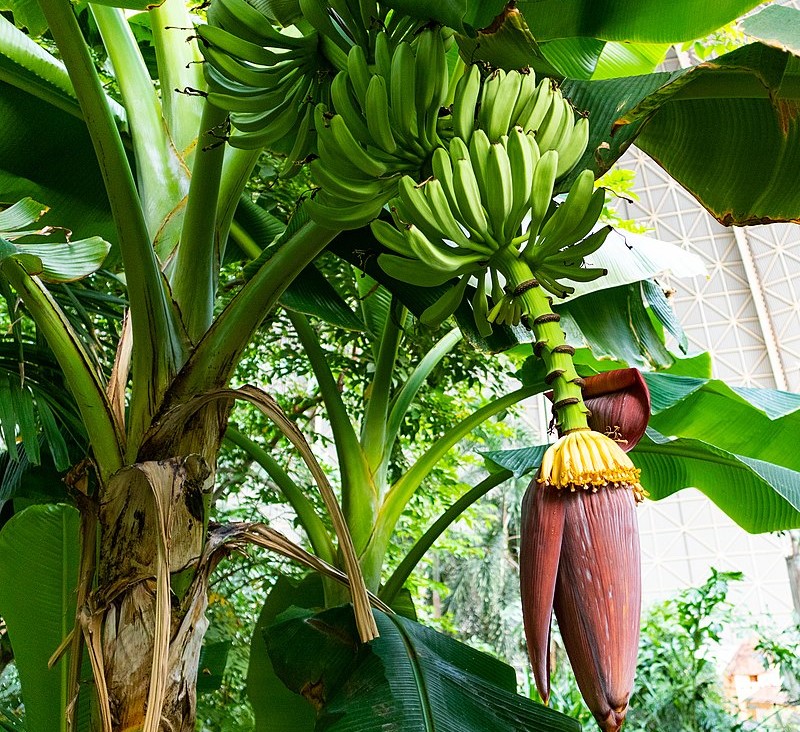Musa paradisiaca

|
|
Musa paradisiaca Common Names: Plantain, Cooking Banana, True Plantain Scientific
Classification Kingdom: Plantae Clade: Tracheophytes Clade: Angiosperms Order: Zingiberales Family: Musaceae Genus: Musa Species: M. paradisiaca Synonyms: Musa corniculata Lour., Musa sapientum L., Musa × paradisiaca L. Morphological Description Musa paradisiaca is a large, perennial herbaceous plant in the Musaceae
family, often mistaken for a tree due to its height of 3–8 m. It is a hybrid
of Musa acuminata and Musa balbisiana: · Pseudostem: Robust, 20–30 cm in diameter, formed by tightly packed leaf
sheaths, green to reddish (Horry et al., 1997). · Leaves: Broad, 1–3 m long, 30–60 cm wide, spirally arranged, easily
torn by wind, bright green (Ploetz et al., 2007). · Flowers: Borne in drooping inflorescences, 1–2 m long, with
reddish-purple bracts; female flowers develop into fruit (Horry et al., 1997). · Fruit: Elongated, curved, 15–30 cm long, green ripening to yellow,
starchy, typically cooked (Ploetz et al., 2007). Distribution and Habitat Musa paradisiaca is cultivated pantropically, originating from Southeast
Asia: · Range: Southeast Asia (Malaysia, Indonesia), Central/South America
(Colombia, Brazil), Africa (Nigeria, Uganda); naturalized in humid tropics
(Horry et al., 1997). · Habitat: Thrives in wet tropical climates, 25–30°C, rainfall
1,500–2,500 mm annually; prefers fertile, well-drained loams, pH 5.5–7.0,
elevations 0–1,200 m (Ploetz et al., 2007). Ethnopharmacology Musa paradisiaca, commonly known as plantain, is a tropical plant esteemed for its
nutritional value and diverse medicinal properties. Various parts of the plant,
including the fruit, peel, leaves, flowers, sap, and roots, have been
traditionally utilized to address numerous health conditions. The peel is rich
in phytochemicals exhibiting significant antioxidant properties, which help
mitigate oxidative stress and reduce the risk of cardiovascular and
degenerative diseases, as well as cancer. Extracts from different parts of the
plant have demonstrated antimicrobial activity against various pathogens,
supporting their use in treating infections. The sap and leaves are applied to
wounds and burns to promote healing, with studies indicating enhanced wound
contraction and increased resistance to wound fracture. Research also
highlights the plant's anti-inflammatory and analgesic effects, with specific
doses significantly reducing inflammation and pain in animal studies.
Gastrointestinal benefits include the fruit's mild laxative properties aiding
digestion and relieving constipation, while the plant sap has been used to
treat dysentery and diarrhea. Cooked flowers are traditionally administered to
individuals with diabetes, as unripe fruits have shown antihyperglycemic
effects, potentially improving insulin sensitivity and glucose metabolism.
Additionally, leaf and fruit peel extracts have been observed to improve lipid
profiles by reducing cholesterol levels, offering cardioprotective benefits.
The inflorescence extract has demonstrated immunomodulatory properties,
particularly in reducing airway inflammation by suppressing specific immune
responses, suggesting potential therapeutic applications in inflammatory airway
diseases. These diverse medicinal attributes underscore the significance of Musa paradisiaca in traditional medicine
and highlight its potential in developing therapeutic agents. · Antimicrobial: Peels in Nigeria treat infections. Ajijolakewu et al. (2021)
found peel extracts (MIC 25 µg/mL) inhibited Escherichia coli and Candida albicans. · Wound Healing: Leaves in Ghana heal ulcers. · Antidiabetic: Fruit in India regulates glucose. Abdel Aziz et al. (2020)
reported In a study involving diabetic rats induced by nicotinamide and
streptozotocin (NA/STZ), administration of Musa paradisiaca leaf and fruit peel
hydroethanolic extracts led to significant improvements in oral glucose
tolerance and elevated serum insulin and C-peptide levels. Markers of insulin
resistance (HOMA-IR) and insulin sensitivity (QUICKI), along with β-cell
function (HOMA-β), showed notable enhancement following treatment.
Additionally, elevated serum levels of free fatty acids, TNF-α, and IL-6 were
markedly reduced. Gene expression analyses revealed upregulation of adipose
tissue PPARγ, GLUT4, adiponectin, and insulin receptor β-subunit mRNA, while
resistin expression was downregulated. These findings suggest that Musa paradisiaca
leaf and fruit peel extracts exert antihyperglycemic effects, potentially
through insulinotropic and insulin-sensitizing mechanisms.. · Anti-inflammatory: Roots in Uganda reduce swelling. In wound
healing studies, rats treated with aqueous Musa paradisiaca stem extract
(AMPSE) exhibited significantly greater wound contraction and fracture
resistance compared to those treated with povidone-iodine (PI) and control
groups. Administration of 900 mg/kg AMPSE also resulted in notable
anti-inflammatory and analgesic effects (p < 0.05) relative to controls.
These findings suggest that AMPSE possesses anti-inflammatory, analgesic,
hepatoprotective, lipid-lowering, and wound-healing properties, supporting its
therapeutic use in traditional medicine Ekweogu et al. (2024). · Antioxidant: Peels in Brazil combat oxidative stress. Fatemeh et al.
(2012) noted peel phenolics (50 µg/mL) scavenged DPPH radicals by 70%. ⚠ Toxicity Profile: Unripe fruit high in tannins (>2%) may cause
constipation or gastrointestinal irritation if overconsumed (e.g., >500
g/day). Latex from leaves/pseudostem can irritate skin due to serotonin and
phenolic compounds. Avoid in excess during pregnancy due to potential uterine
stimulation (Imam & Akter, 2011). Additional Uses · Culinary: Boiled, fried, or mashed in dishes like matoke (East
Africa), tostones (Caribbean); rich in carbohydrates (Ploetz et al., 2007). · Industrial: Leaves as food wrappers, pseudostem fibers for ropes, mats
in Southeast Asia. · Cultural: Fermented into beer (e.g., mbege in Tanzania); pseudostem
ash as salt substitute (Ajijolakewu et al., 2021). References
External Links More Pictures
|
|
| Compounds of Musa paradisiaca | |
| References |